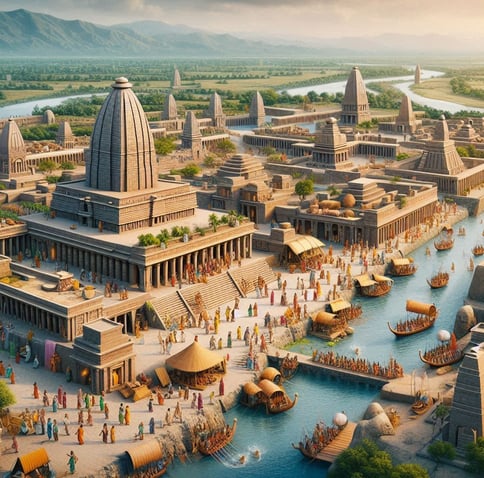Indus Valley Civilization: Sustainable Urban Design Insights
Explore the 5,000-year-old Indus Valley Civilization, renowned for its sustainable urban design, advanced drainage systems, and egalitarian housing. Discover ancient innovations in water management and waste recycling that offer vital lessons for modern cities facing climate change challenges.
WiserFool
Introduction
The Indus Valley Civilization (circa 3300–1300 BCE), one of the world’s earliest urban cultures, flourished in the basins of the Indus River and its tributaries. Spanning modern-day Pakistan, northwest India, and Afghanistan, its cities—like Mohenjo-Daro, Harappa, and Dholavira—were marvels of advanced urban planning. But beyond their architectural brilliance, these cities offer timeless lessons in sustainability, a concept critical to our modern climate crisis. By examining their infrastructure, resource management, and social organization, we uncover a blueprint for harmonious living that balances human needs with environmental stewardship.
The Pillars of Indus Urban Planning
1. Grid-Based Cities: Order and Efficiency
Indus cities were meticulously organized on a grid system, with streets intersecting at right angles. This layout promoted:
Traffic Flow: Wide main streets (up to 10 meters) and narrower lanes ensured efficient movement.
Zoning: Residential and public areas were distinct yet integrated.
Flood Resilience: Elevated citadels and carefully aligned streets minimized flood damage.
Sustainability Lesson: Grid planning reduces urban sprawl and optimizes land use, a principle echoed in modern “smart cities.”
2. Water Management: Harnessing Nature
The Indus people mastered water conservation and distribution:
Sophisticated Drainage Systems: Every house had a private well and bathrooms connected to covered, centralized drains made of brick. Wastewater flowed into street sewers, preventing contamination.
Public Water Infrastructure: The Great Bath of Mohenjo-Daro (a large, waterproofed pool) highlights communal water management, possibly for ritual or civic use.
Rainwater Harvesting: Cities like Dholavira had intricate reservoirs and channels to capture monsoon rains.
Sustainability Lesson: Decentralized water systems and wastewater segregation are models for modern cities battling water scarcity.
3. Waste Management: Circular Economy
Indus cities prioritized hygiene and recycling:
Trash Chutes: Houses disposed of waste via chutes into municipal bins, which were likely repurposed.
Minimal Waste: Archaeological finds show limited household waste, suggesting efficient reuse of materials.
Sustainability Lesson: Circular waste systems reduce landfill dependency—a practice now central to zero-waste movements.
4. Architecture: Durability and Equity
Standardized Materials: Uniform, kiln-fired bricks (1:2:4 ratio) ensured structural consistency and disaster resilience.
Egalitarian Housing: Most homes were similar in size, with access to basic amenities. The absence of palaces or temples hints at a class-minimal society.
Sustainability Lesson: Durable, equitable housing reduces resource inequality—a goal of today’s affordable housing initiatives.
5. Trade and Localized Production
Self-Sufficient Cities: Each urban center produced goods like pottery, beads, and textiles locally, minimizing long-distance resource strain.
Regional Trade Networks: Indus seals found in Mesopotamia reveal trade in timber, cotton, and gems, but without overexploitation.
Sustainability Lesson: Balancing local production with ethical trade aligns with today’s “localvore” and fair-trade movements.
Why Did the Indus Civilization Decline?
While debates continue, theories include:
Climate Change: Shifts in monsoon patterns and river courses (e.g., the Ghaggar-Hakra drying up).
Overcentralization: Reliance on river systems may have left cities vulnerable to ecological shifts.
Sustainability Takeaway: Even resilient systems must adapt to dynamic environmental conditions.
Modern Applications: Learning from the Past
Green Infrastructure: Cities like Copenhagen and Singapore use Indus-inspired decentralized water systems and green roofs.
Inclusive Urban Design: Mixed-income housing projects mirror Indus equity principles.
Circular Economy: Amsterdam’s 2050 plan to reuse all materials echoes Indus waste practices.
Climate Resilience: Flood-resistant architecture in the Netherlands draws from Indus elevated foundations.
Conclusion
The Indus Valley Civilization’s legacy is not just archaeological—it’s a manifesto for sustainable living. Their cities thrived for millennia by prioritizing environmental symbiosis, social equity, and long-term planning. As we face rising seas, resource depletion, and urban chaos, their ancient wisdom urges us to rethink modern development: Sustainability isn’t innovation—it’s revival.
By blending their time-tested strategies with today’s technology, we can build cities that don’t just survive, but thrive—for another 5,000 years.


